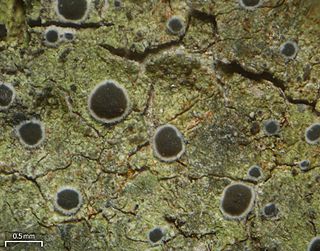
The Pilocarpaceae are a family of crustose lichens in the order Lecanorales. The species of this family have a cosmopolitan distribution and have been found in a variety of climatic regions. Pilocarpaceae was circumscribed by Alexander Zahlbruckner in Adolf Engler's influential 1905 work Die Natürlichen Pflanzenfamilien.

The Graphidaceae are a family of lichen-forming fungi in the order Graphidales. The family contains nearly a hundred genera and more than 2000 species. Although the family has a cosmopolitan distribution, most Graphidaceae species occur in tropical regions, and typically grow on bark.

Fissurina is a genus of lichenized fungi in the family Graphidaceae. It has about 160 species, most of which are found in tropical regions.

Diorygma is a genus of lichen-forming fungi in the family Graphidaceae. The genus was circumscribed by Franz Gerhard Eschweiler in 1824. Species of the genus are widely distributed in tropical and subtropical regions of the world.

Acanthothecis is a genus of lichen-forming fungi in the family Graphidaceae. The genus was circumscribed by Frederick Edward Clements in 1909.
Chroodiscus is a genus of leaf-dwelling lichens in the family Graphidaceae. It was first introduced by Swiss lichenologist Johannes Müller Argoviensis in 1883 as a section of the genus Ocellularia. In 1890 he promoted it to generic status.

Byssoloma is a genus of leaf-dwelling lichens in the family Pilocarpaceae.
Badimia is a genus of foliicolous (leaf-inhabiting) lichens in the family Ramalinaceae.

Enterographa is a genus of lichens in the family Roccellaceae.
Arthotheliopsis is a genus of fungi in the family Gomphillaceae. It has 5 species. The genus was circumscribed by Finnish lichenologist Edvard August Vainio in 1896, with A. hymenocarpoides assigned as the type species.
Gyalectidium is a genus of lichen-forming fungi in the family Gomphillaceae. A 2020 estimates placed 52 species in the genus. The genus was circumscribed by Swiss lichenologist Johannes Müller Argoviensis in 1881. He included 3 species: G. xantholeucum, G. dispersum, and G. filicinum; the last of these is now the type species of the genus.

Gyalidea is a genus of crustose lichens in the family Gomphillaceae. It has 50 species.

Absconditella is a genus of lichenised fungi in the family Stictidaceae. The genus was circumscribed in 1965 by Czech lichenologist Antonín Vězda, with Absconditella sphagnorum assigned as the type species. Absconditella is characterised by gyalectoid apothecia with a hymenium that is not amyloid, without a dark pigment and thalli containing green algae as photobionts. The genus name means "hidden", a reference to the scant structure of the thallus and its small apothecia.
Gyalideopsis vainioi is a species of lichen in the family Gomphillaceae. It was described as new to science in 1988 by Klaus Kalb and Antonín Vězda from Brazilian collections. The variety Gyalideopsis vainioi var. semicirculataLücking & W.R.Buck was published in 2007; it was found in Florida. The specific epithet honours Finnish lichenologist Edvard Vainio, known for his pioneering work with Brazilian lichens.
Antonín (Toni) Vězda was a Czech lichenologist. After completing a university education that was postponed by World War II, Vězda taught botany at the Czech University of Life Sciences. In 1958, he was dismissed from his university position as a result of the restrictions placed on academic freedoms by the communist regime in power. He eventually was hired as a lichen researcher by the Czechoslovak Academy of Sciences, who allowed him to work from his apartment, which served also as an office and herbarium.

Coenogonium is a genus of crustose lichens in the monotypic family Coenogoniaceae. It has about 90 species. Most species are leaf-dwelling or grow on bark, although a few are known to grow on rocks under certain conditions, and some are restricted to growth on termite nests. The genus was circumscribed in 1820 by German naturalist Christian Gottfried Ehrenberg.
Arthotheliopsis serusiauxii is a species of leaf-dwelling lichen in the family Gomphillaceae. It was first formally described as a new species in 1997 by Robert Lücking, as a member of genus Echinoplaca. The type specimen was collected in Costa Rica, growing on the leaves of a dicotyledon. The specific epithet honours Belgian lichenologist Emmanuël Sérusiaux. In 2005, Lücking, Sérusiaux, and Antonín Vězda transferred it to genus Arthotheliopsis after a molecular analysis of the Gomphillaceae helped to clarify the phylogenetic relationships in the family.

Robert Lücking is a German lichenologist. He is a leading expert on foliicolous lichens–lichens that live on leaves.
Graphidales is an order of lichen-forming fungi in the class Lecanoromycetes. It contains 6 families, about 81 genera and about 2,228 species. Family Graphidaceae are the largest crustose family within Graphidales order comprising more than 2000 species, which are widely distributed in tropical and subtropical regions of the world.
Aspidothelium is a genus of lichen-forming fungi in the family Thelenellaceae. All species in the genus have a tropical distribution and are crustose with a chlorococcoid photobiont partner. Most Aspidothelium species are foliicolous (leaf-dwelling), although some corticolous (bark-dwelling) species are known, as well as a single saxicolous (rock-dwelling) member.









